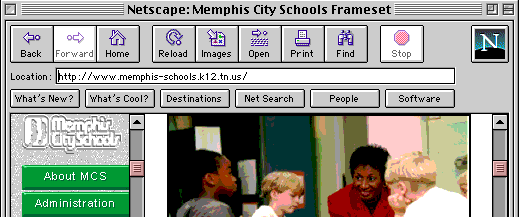
 |
Links for K-12 Teachers | Assessment Assistance | On-Line Practice Modules | Daily Dose of the Web
Using the Menus | Using the Toolbar | Getting out of a Frame | Managing Bookmarks | Scrolling Techniques
Characteristics of a Frame
The web site illustrated below is organized through the use of frames. Notice that there are two scroll bars in the image below. One in the standard location on the far right, and one to the right of a set of green buttons. The set of green buttons provide a navigation menu, assisting the user with getting around on the web site

From the set of green navigation buttons, I
selected ![]() which carried me to the screen shown below. Notice that the logo and
green buttons are in the same place. They did not move because this
web site actually consists of three separate web pages.
which carried me to the screen shown below. Notice that the logo and
green buttons are in the same place. They did not move because this
web site actually consists of three separate web pages.
- The frame set web page which controls the operation and appearance of the entire page
- The navigation button web page which remains in that place as long as you are in the frame set
- The target or featured web page that is selected from the navigation buttons

Look closely at the location block of each of the two screens displayed above. The Uniform Resource Locators (URL's) are identical. If I book marked the second window so that I could return to the Teaching and Learning Academy from my bookmarks menu later, I would be out of luck. The bookmark would carry me to the first screen instead.
Getting out of a Frame
To create bookmarks it is first necessary to get out of the frame set Instructions for doing this are slightly different for Macintosh and IBM users.

Select "New Window with this Link."

You are now out of the frame. Notice the location block. A bookmark created to the web page in this window would return you to this site later, not the original frame set
Webmasters: Helping users to get out of a Frame
If a page you have written is displayed within a frame and users may want to bookmark that specific page rather than the frame set, you can help them.
Near the top of the web page displayed above you will find the phrase shown immediately above this line. If a user clicks on the link "here," they are transported out of the frame to the Teaching and Learning Academy web page. The link does the same thing as the steps above. If you visit the Teaching and Learning Academy web page and view the page source you will find how this is done.
In Netscape 3 and earlier, go to the View menu and select Document Source. You see the HTML document used to create the page. On that page you will find the following command:

To use this on your web page insert the URL of your page between the quotation marks, leaving everything else the same. If you do not want the line to be bold, do not use the <STRONG> tag.
Thanks to Seth Agranov from Gordon Elementary in Memphis, TN for discovering a more simple code. Copy the 4 lines below and put them in the head of your web page. Your page will leap out of whatever frame it was stuck in before.
<script LANGUAGE="JAVASCRIPT">
<!C-
if (top.frames.length!=0)
</script>
If you have questions about using a Netscape browser you might go to this index to lists of technical articles for various Netscape browsers, current and older versions. You can select a link below to view all of the technical articles that apply to the product you've selected, or use the search engine to look for a specific topic.
Downloading other versions of Netscape
Netscape Communicator 4.5 - available for Mac 7.6 or higher or Windows 95/98/NT
Netscape Communicator 4.0 - available for Mac or Windows 3.1/95/98/NT
Archived versions including:
Other Netscape tutorials

Custom Search
|
Visitors since November 2000 |
Memphis, TN |